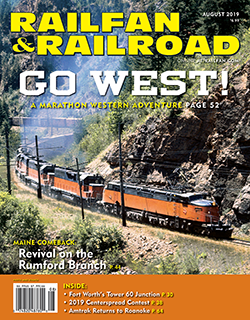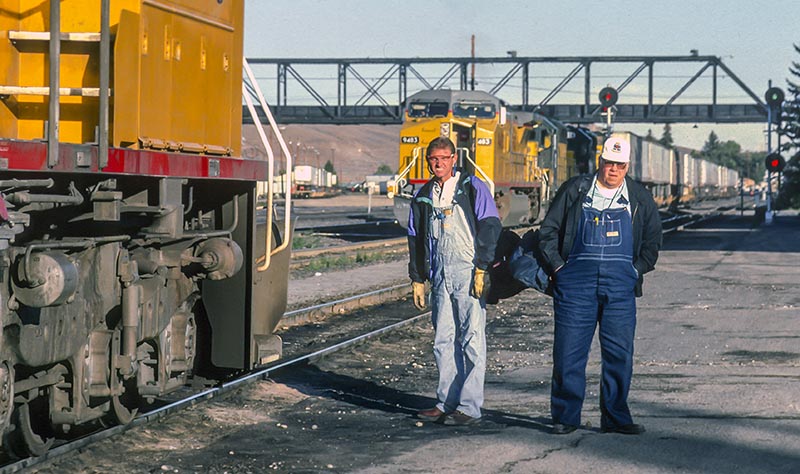 Railroad unions play a vital role in keeping rail transportation safe, but unions have many different roles and sometimes those roles can be at odds with each other. I do not mean to imply that unions conspire to make railroading unsafe, but unions can play the safety card on issues that have little or nothing to do with safety.
Railroad unions play a vital role in keeping rail transportation safe, but unions have many different roles and sometimes those roles can be at odds with each other. I do not mean to imply that unions conspire to make railroading unsafe, but unions can play the safety card on issues that have little or nothing to do with safety.
The danger is that union lobbying tactics can backfire, and those tactics can inadvertently result in unsafe situations. It is a complicated matter, and I see the danger that a current union campaign may cause rail unions to stumble into unsafe situations.
Let me explain, beginning with the current union campaign, led by the Transportation Trades Department of the AFL-CIO. Unions have consistently called for keeping two-person engine crews on all freight trains, and it would be expected that would be part of their current campaign. However, the reasons given by the unions stretch into other areas. “Operating a two-mile-long freight train carrying hazardous materials is a complex task that requires precision, specialized training, and the kind of careful attention to detail only two qualified crew members can provide,” the union statement said. “Despite this, the FRA recently chose to put profits over safety by failing to regulate train crew size and, outrageously, barred states from setting their own rules on train crew size. Rail unions will now call on Congress to put safety first by passing federal legislation requiring a certified conductor and engineer on freight.” This is only one way the unions stepped up pressure on the railroads and the government. Note that if states can set their own rules on train crew size, the states could require three or even four crew members on freight trains. Why is it outrageous to prevent that? It was years ago that the federal government cracked down on this practice.
Chronic fatigue is a well-documented rail safety problem. Rail work “inherently involves demanding and irregular work schedules,” the report said. All the problems can “be addressed by Congress with sensible reforms to the Hours of Service Act.”
It is well known that rail crew members are strictly held to 12 hours on duty and, generally, 10 hours off duty. The union proposals included an intriguing idea that, unless I’m missing something, sounds excellent. Instead of just 10 hours off duty, after which the employee can be called on perhaps a two-hour notice, give the employee a call 10 hours before he or she is scheduled to go on duty. If that is 15 or 20 hours after the last trip, it would be possible to plan a life and maybe have a glass of wine. If it is only 10 hours, the employee knows it’s time to get to bed. There’s no uncertainty.
“Modern freight trains routinely weigh 15,000 to 20,000 tons and stretch over a mile long,” the unions wrote. “These trains travel through thousands of communities throughout the country and carry everything from food to hazardous materials. Yet carriers have opposed every effort to require two-person crews and have indicated a desire to move toward single crewmember operations in the near future. This unsafe practice heightens the risk of a safety accident and places an undue burden on the shoulders of the single operator.”
Railroads say that emerging technologies, such as PTC, eliminate the need for a second crewmember. The unions say this not only is false, it potentially nullifies the safety benefits of emerging technology. “The reality is a single crew member cannot perform all of their tasks, maintain the highest levels of safety, and respond appropriately in the event of an emergency, regardless of technology,” the unions wrote. “An overwhelming majority of Americans agree. Over 80 percent of respondents, regardless of party affiliation, believe that one-person train crews are unsafe and would support a law requiring two-person crews.” The unions did not say who was included in the poll.
The unions wrote: “In emergencies, the onboard conductor and engineer double as the first responders, provide critical information to local law enforcement and emergency personnel, and work together to uncouple train cars that may block roads or the paths of emergency vehicles.”
Other proposals are confusing. The unions call on the government and industry to prevent Mexican crews from running trains even a short distance into the U.S. They gave the example of Kansas City Southern allowing Mexican crews to run nine miles from Mexico to the yard at Laredo, with permission from the FRA. My first reaction was, “Why not?” The union notes that current regulations allow the Mexican crews to avoid random drug and alcohol testing. If that’s bothersome, change the rule. The union also says there is “no proof” Mexican crews are required to have the same certification and training requirements as American crews. So? Change the requirements if need be.
Some complaints are obviously exaggerated but bothersome. The unions say they will raise “serious concerns” about a business model that prioritizes profits for Wall Street investors above everything else “including safety.”
The unions also say that “as more Class I railroads transition to so-called precision railroading, trains are getting longer, schedules are getting tighter, and workforces are being slashed. Front line rail workers report being overworked, stressed out, and even scared to speak out. Some are now required to perform double and triple their regular workloads while others say they feel pressure to meet strict deadlines no matter the cost. One machinist union member reported having mere seconds to perform a safety-sensitive inspection. Rail workers and their unions will call for greater government oversight and a crackdown on unchecked corporate greed.”
Does this sound overdone? Perhaps a little. Does it call for quick and firm action? Definitely.
I had no idea that workplace violence had become such a problem with passenger-carrying railroads, including Amtrak and commuter trains. The unions called for legislation to “require carriers to develop, in conjunction with their employee unions, comprehensive assault prevention and response plans that include de-escalation and self-defense training, protocols for reporting incidents and notifying law enforcement, and policies for any affected employees to pursue legal recourse without any negative effects on their employment status. Workplace violence is a growing problem that will not go away without direction from Congress and the administration, and rail workers simply cannot wait for action any longer.”


